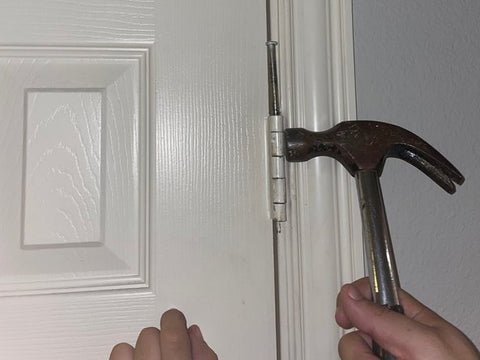
Think of it this way: your door hinge is like a tiny orchestra. Sometimes, you just need to adjust the sound to make the whole piece flow smoothly. By using some simple household items, you can quiet that noisy hinge temporarily and restore harmony to your home. Let’s dive into some creative methods that can help you tackle this pesky issue!
Why Do Door Hinges Squeak?
You might be wondering, “What causes all this noise in the first place?” Door hinges squeak for a variety of reasons. Most often, it’s due to a lack of lubrication. Over time, dirt and grime can accumulate in the hinge, creating friction that leads to those annoying sounds. But it’s not just about the lack of lubricant. Environmental factors, like humidity, can also play a role. When hinges rust, they’re more likely to squeak.
Additionally, if a hinge is misaligned or loose, it can cause unwanted movement and create noise. So, while we can give it a quick fix without lubricant, knowing why it’s squeaking helps us understand the issue better. Think of your hinge as a little machine; it needs to run smoothly to avoid unnecessary noise.
Temporary Fixes for Noisy Hinges
If you’re in a pinch and need a quick fix, there are several household items you can use to silence that squeaky hinge temporarily. Here are some effective methods:
- Pencil Graphite: Yes, you read that right! Simply rub the tip of a pencil on the squeaky hinge. The graphite acts as a dry lubricant, reducing friction and quieting the noise.
- Soap: A bar of soap can do wonders. Just rub the soap directly on the hinge. It’s a quick fix that often works surprisingly well to dampen those squeaks.
- Petroleum Jelly: If you have petroleum jelly around, that can help too. Apply a small amount to the hinge and move the door back and forth. It’ll provide a temporary barrier to noise.
- Cooking Oil: In a bind, cooking oil, like olive oil, can also work. Just be careful not to overdo it, as it can attract dust over time.
These methods are simple and effective. Just remember, they’re temporary fixes. You’ll want to look into a more permanent solution when you have the time.
Steps for Using Pencil Graphite
Let’s break down how to use pencil graphite to silence that noisy door hinge.
1. Gather Supplies: You’ll need a pencil (preferably a regular graphite pencil, not mechanical).
2. Locate the Hinge: Open the door and identify the squeaky hinge. It’s usually the one you hear most when you open or close the door.
3. Apply Graphite: Rub the pencil tip directly onto the hinge. Make sure to cover the entire area where the two sections of the hinge move.
4. Move the Door: Open and close the door a few times. This helps the graphite work into the hinge and reduces squeaking.
It’s a quick and easy method that anyone can try. If you don’t have a pencil handy, don’t worry; there are other methods we can explore.
The Soap Method Explained
Using soap to silence your noisy hinge is an unconventional but effective trick. Here’s how to do it:
1. Choose the Right Soap: You can use any bar soap, preferably one that’s not too fragrant or oily.
2. Rub the Soap: Take the bar and vigorously rub it along the hinge itself. You want to coat the areas where the metal touches.
3. Check if it Works: After applying, open and close the door. The sound should noticeably diminish.
The soap acts as a temporary lubricant, filling in gaps that cause squeaking. If you’re using a decorative soap, just be aware that the scent might linger!
Combining Methods for Best Results
If one method doesn’t do the trick, don’t hesitate to combine techniques! Sometimes, using both graphite and soap can provide a better outcome. Here’s how:
1. Start with Graphite: Begin with the pencil graphite method, rubbing it on the hinge thoroughly.
2. Follow with Soap: Next, apply the bar soap in the same spots. The combination will create a more robust barrier against squeaking.
3. Test It Out: Open and close the door. If the noise persists, you might need to look into realigning the hinge or considering a more permanent solution.
Combining methods can often maximize their effectiveness, giving you a quieter door in no time.
When to Consider Permanent Solutions
While these temporary fixes are great for the short term, it’s important to think about long-term solutions too. If your door hinge continues to squeak after trying various methods, it might be time for a deeper dive.
– Inspect the Hinge: Check for rust or damage. A rusty hinge may need replacing entirely, while a loose hinge might just need to be tightened.
– Proper Lubrication: When you’re ready, using a dedicated lubricant (like WD-40) can provide a more lasting solution. It penetrates well and protects against dust and moisture.
– Replacement: If the hinge is old and worn out, getting a new one can save you from future squeaks.
Remember, every temporary fix has its limits, so keep that door moving smoothly with a proper check-up every now and then.
Silencing a noisy interior door hinge without lubricant is entirely doable with just a bit of creativity and common household items. Whether you decide to use pencil graphite, soap, or even a dash of cooking oil, you can quickly restore peace to your home. Just keep in mind that these are temporary solutions; re-evaluating the hinge condition and considering permanent fixes down the line is always a wise move. With a little effort, you can enjoy quiet doors and a more serene living space. So go ahead, give these methods a try, and reclaim your peace!